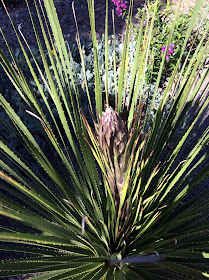I was recently able to preview the seven gardens that will be featured on this year's
Association of Northwest Landscape Designers (ANLD) tour. This annual tour is always good but I thought this year's lineup was especially nice.
The gardens featured on the tour are all on standard sized lots in the SE and NE Portland area. They suffered from a range of typical problems: poor flow, bad drainage, struggling lawns, or lack of privacy. I think this tour really highlights the problem-solving that landscape designers provide.
The Bebernes-Gawf garden was possibly my favorite on the tour. A crumbling, unused driveway was transformed so artfully into garden space that I didn't even realize it until I hit the garage door. Usable space was incorporated into a small yard in a way that makes it feel like it was originally built that way.
That broken driveway was cut into strips and used to create a raised bed that borders a path leading to a secret garden. I LOVE when designers are able to keep resources on site instead of hauling it to the dump.
At the end of the secret garden there's a shelter where the owners can watch the rain fall and enjoy a pot of tea. Read more about
this garden here.
How do you garden when you live beneath two huge maples that suck every bit of water from the soil and rob your plants of sunlight? What does a landscape designer do in their own yard? Linda Hannan's garden answers those questions. A garden "she would never design for someone else," it is nonetheless exuberant, beautiful, and full of great ideas for using a small space to entertain AND propagate plants.
See more of the Hannan garden here.
The King garden suffered from the one-two punch of a swampy lawn AND overgrown evergreens in an unremarkable lot. It has been transformed into a lush but low-water oasis, perfect for entertaining and playing with their dog.
Read more about this garden here.
The Langeliers garden was originally an enormous lawn on an oversized lot. The homeowner was overwhelmed with the amount of lawn and underwhelmed with the mood it created. The designers created a strolling garden full of texture, color, sound, and movement. I absolutely loved this garden.
You can read more about it here.
The Ohlson garden faced a number of challenges, as it is located in historic Ladd's Addition. Onerous restrictions from the neighborhood and the city made it a challenging garden to design, though you'd never know it looking at the final product.
You can read more about it here.
The Wagner garden was originally a moss-filled lawn, which suffered from drainage issues during the wet months. It's now a lush mix of mixed beds, edibles, and a much healthier lawn.
You can read more about it here.
The Mauch garden was formerly a lawn with some rhodies, like thousands of others in Portland. The owner needed a low-maintenance garden on a small budget. The designer created a lush oasis that fit the parameters AND worked around a remodel to the back of the house.
You can read more about it here.
Occasionally I've been asked by friends to design their gardens. I garden, so surely I can design one for them, right? A good designer not only has an encyclopedic knowledge of plants, they also know how to solve problems like competition from existing trees, poor drainage, lack of light, or poor access/unusable space. I can't do that. I can't even give my plants the space they need. A good designer will knock out a killer hardscape plan and a planting design that will work with your site and your budget.
The tour is Saturday June 18th. It is self-guided, so you can visit the gardens in any order you prefer. Tickets are available on
the ANLD website or at Garden Fever, Al's, Portland Nursery, or Cornell Farm.
I am also giving away one ticket. If you'd like to win, please leave a comment saying, "Count me in!" or something to that effect. I'll announce the winner next week.
































